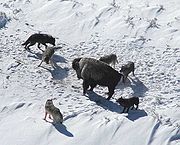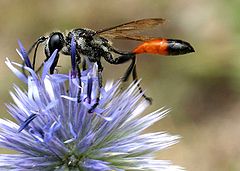
Presociality
Encyclopedia


- Overlap of adult generations,
- Reproductive division of labor, and
- Cooperative care of young.
Presocial behavior is much more common in the animal kingdom than complete eusociality. Examples include canines
Canidae
Canidae is the biological family of carnivorous and omnivorous mammals that includes wolves, foxes, jackals, coyotes, and domestic dogs. A member of this family is called a canid . The Canidae family is divided into two tribes: Canini and Vulpini...
that live in packs, numerous insects, especially hymenoptera
Hymenoptera
Hymenoptera is one of the largest orders of insects, comprising the sawflies, wasps, bees and ants. There are over 130,000 recognized species, with many more remaining to be described. The name refers to the heavy wings of the insects, and is derived from the Ancient Greek ὑμήν : membrane and...
, humans, many birds, chimpanzee
Chimpanzee
Chimpanzee, sometimes colloquially chimp, is the common name for the two extant species of ape in the genus Pan. The Congo River forms the boundary between the native habitat of the two species:...
s, and many other animals that display social behavior.
Some sociobiologists further categorize types of presociality:
- Subsocial: parents interact with young
- Parasocial: individuals of the same generation live in a single, cooperative dwelling and interact with each other
- Communal: each individual cares exclusively for her or his own young
- Quasisocial: individuals care cooperatively for the entire brood; however, all members of the colony are reproductive
- Semisocial: a limited group of individuals reproduces, yet the arrangement is not quite eusocial. Adult generations might not overlap, the reproductive dominance might be temporary, or some other requirement is not met.
The path to each of these stages of sociality is highly varied between different groups of animals. Sociality itself can be seemingly contrary to the theory of Darwinian evolution. Darwin saw the phenomenon as a serious challenge for his theory to overcome. However, modern sociobiology has been able to explain many cases of social behavior.
Among the Vespidae, it is thought that the pressures of predators and parasites selected subsocial behavior; that is, when the mother wasp stays in her brood cell to watch over her larva, it becomes less likely that parasites will be successful in preying on the nest.
Other pressures can force the evolution of presociality. A lack of resources available to pack-wolves makes it possible to raise only one litter, even with the aid of the pack. This forces reproduction to be suppressed in all but the alpha-male and -female; this way, the non-reproducing members of the pack can focus all of their care on one litter rather than several unsuccessful ones.

